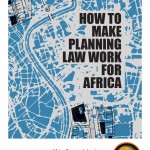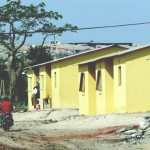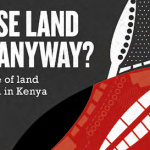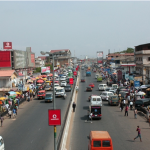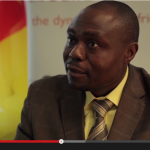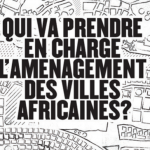Africa’s cities are growing – and changing – rapidly. Without appropriate planning, they will become increasingly chaotic, inefficient and unsustainable. In many countries, planning legislation dates back to the colonial era. It is ill-equipped to deal with contemporary urban problems. A shortage of urban planning and management professionals trained to respond to urban complexity with progressive pro-poor approaches exacerbates urban dysfunction.
As planning educators seek to train students for employment within the existing system, the urban and rural planning curricula of many planning schools are as outdated as planning legislation. Some African countries have no planning school. The reform and revitalisation of planning education – and legislation – could contribute significantly to sustainable and more equitable urban development in sub-Saharan Africa.
Vanessa Watson is Professor of City and Regional Planning at the University of Cape Town, South Africa, and co-chair of the Association of African Planning Schools (AAPS) steering committee.
Babatunde Agbola is Professor of Urban and Regional Development at the University of Ibadan, Nigeria, and chair of the AAPS steering committee.
In 2012, planning students at Makerere University and members of the National Slum Dwellers Federation of Uganda concluded a four-month “urban studio”. The purpose of this unusual collaboration was to survey living conditions in six Ugandan informal settlements. For many of the students, this was their first experience of daily life in an informal settlement. With residents and Federation staff acting as “community professors”, and planning students contributing technical knowledge, a vibrant two-way learning partnership was initiated.
Enumeration and mapping exercises provide invaluable evidence about informal settlements. Many such settlements, throughout Africa, do not even appear on official maps. At the conclusion of the urban studio in Uganda, the students and Federation members presented reports to the municipal authorities and communities. These included detailed information on education, income and savings, land tenure and access to basic services in the informal settlements. An indispensable resource for guiding the planning of inclusive, pragmatic urban development in the study areas had been created.
Urban planners in Africa are confronted by a daunting task. An urban crisis is being fuelled by growing numbers of inhabitants without access to shelter, basic services or formal employment opportunities. Vigorous, often unrestrained, development of any available and well-located urban land is widespread. Environmental hazards are escalating, compounded by waste, air pollution and the effects of climate change. Conventional urban planning practices and systems that remain trapped in the past are failing to counter these threats.
Planning is the single most important tool that governments have at their disposal for managing rapid urban population growth and expansion.
The prevailing image of urban and regional planning in Africa depicts a disengaged, technical and apolitical profession. A more critical view holds that planning is deeply political, its overriding purpose being to further the interests of political and economic elites. There is little enthusiasm for reform from within. Yet planning is the single most important tool that governments have at their disposal for managing rapid urban population growth and expansion. If inclusive and sustainable planning replaced outdated, controlling and punitive approaches it would underpin more equitable and economically productive urban development in Africa.
Crucially, change depends on planners who are innovative problem-solvers and willing to collaborate with all parties involved in the development process, including local communities. Their actions will need to be informed by explicit and progressive values. The education of these future planners requires thorough reappraisal of existing teaching methods, the introduction of new ones, and remodelled curricula.
In the absence of a well-resourced and functioning planning system, development fosters dealmaking among the influential and financially better-off – rather than compliance with accepted and transparent planning processes. Private tenement block construction in and around Kibera, Nairobi’s largest informal settlement, is a prime example of this phenomenon. As most of the development does not conform to planning or building regulations, it is as unauthorised as the neighbouring shacks. The seven- or eight-storey tenements are largely ignored by city authorities because they appear “formal” – or because of financial inducements. The fire, collapse and health risks of such tenements are seldom subjected to rigorous official scrutiny.
Most urban development in sub-Saharan Africa is occurring in a completely non-planned and non-transparent manner.
The vision of the future for Africa’s cities was often shaped by reference to cities in developed economies – like London, Paris or New York. The master plan for Lusaka, Zambia’s capital city, was based on the concept of the “garden city”, a quintessentially British creation. The unanticipated scale of informal settlement in contemporary Africa is typically ignored, or wished away, by national governments and city authorities.
Old and new master plans are equally exclusionary, albeit in different ways. Older plans, strongly influenced by colonial town planning, put in place zoning schemes with mono-functional land use, plot sizes and building regulations. The urban fantasies – more recent urban master plans – assume either that the existing informal city can be scraped away or that new “smart” or “eco” cities on greenfield sites provide a better alternative to upgrading what is in situ.
Sprawling development intensifies the effects of the scourges of African cities – inadequate infrastructure and economic opportunity, and greater concentrations of people living in areas at high risk from flooding, disease, fire or landslide. Conventional patterns of industrialisation and formal job creation, which accompanied urbanisation in the global North, are absent from most countries in sub-Saharan Africa.
From the outset, it was recognised that if planning schools were to influence governments and planning departments, a pan-African network would need to include as many institutions as possible. The distribution of the 70 or more planning schools in Africa varies widely, as do their educational approaches. Most countries have only one or two planning schools. Angola and the Democratic Republic of Congo (DRC) have no planning schools, whereas Nigeria has 36 schools and South Africa 11. The École Africaine des Métiers de l’Architecture et de l’Urbanisme (EAMAU), in Togo, admits students from 14 francophone countries. In some countries, planning schools do not communicate with one another.
The gap between what planning students were taught and the urban realities they confronted after graduation needed to be reduced.
The establishment of a link with the Global Planning Education Association Network (GPEAN), following the first World Planning Schools Congress in 2001, was an essential spur to the AAPS. By the end of 2007, membership had increased to 26 planning schools. Close ties with the African Centre for Cities in Cape Town, and the first of three tranches of funding from the Rockefeller Foundation, enabled the network to launch its “Revitalising Planning Education in Africa” project.
In 2008, the first major AAPS conference took place in Cape Town. It was attended by academics from 22 member schools and focused on planning curricula. Delegates were each asked to prepare a paper on the most significant planning issues in their city or country, setting out how local planning curricula did – or did not – respond to these. Five main themes emerged from the papers:
- informality
- access to land
- climate change
- collaboration between planners, communities, civil society and other interested parties
- mismatch between spatial planning and infrastructure planning
Groups of delegates with common thematic interests were organised into “communities of practice” tasked with producing papers on each of the five themes. These were presented at the second major AAPS conference in Dar es Salaam, in 2010, by which time the network had expanded to 43 schools. There was general agreement at the conference that the themes were largely unaddressed in African planning curricula.
The University of Zambia’s master’s programme is the first in Africa fully to incorporate the issue of informality.
Educational reform is no easy task in most African universities – or anywhere. Curriculum change is a highly centralised and usually protracted process. Severe financial constraints are commonplace. Underpaid staff undertake consultancy work to make ends meet, library resources are poor, and there is a shortage of computers and other essential equipment. Internet bandwidth is usually very limited, technical support inadequate, and power outages frequent.
It could be argued that the emphasis on the five themes in the new master’s and undergraduate curricula does not leave African planning graduates well prepared for local job markets. On graduation, they might be expected to implement outdated planning legislation, or design golf courses or gated communities for the wealthy. But unless planning students are exposed to the prevailing conditions and trends in African cities, and encouraged to consult and interact with local communities to assess how planning might best address these, they will merely advance the marginalisation of the planning profession – and of the poor – in sub-Saharan Africa.
Planning educators and their students need “to get their shoes dirty”. This imperative has been overlooked in traditional planning education models – and by many practising planners. Local case studies on the use of bicycle-taxis in Malawi, or resistance to market removal in Ghana, or the informal recycling business in Johannesburg, throw into stark relief the completely inappropriate nature of current approaches to planning in African cities.
Case study research generates invaluable, nuanced teaching material – as well as important contributions to our knowledge of African cities. The lamentable deficiency of good data to assist planning practice and policy development in Africa needs to be overcome. Many erroneous assumptions about African urbanisation have gone unchallenged for decades. Case study work is a pre-eminent means of addressing the need to produce new knowledge relevant to practice, enhancing skills and competencies, and establishing values that planners should embrace in the course of their professional careers.
The AAPS organised three case study workshops in different regions of sub-Saharan Africa between 2009 and 2011. For many participants, the work entailed a different approach to gathering and presenting data. They were more accustomed to producing empirical – usually quantitative survey-based – urban research reports. Others presented on the adoption of a case study approach in their teaching and the benefits they had observed of placing students in urban learning studios, working closely with a community or individual in the field.5
The studios have underscored the potential of a two-way learning process. Participating in community enumerations, data collection and mapping, students and staff begin to understand more about the dynamics of informal settlements – and the importance of producing plans that take into account the everyday needs and capacities of their inhabitants. The local knowledge of inhabitants and technical knowledge of students are complementary. Both are needed to shape new approaches to planning in the future. Innovative partnerships have also been agreed between the AAPS and Women in Informal Employment: Globalising and Organising (WIEGO) and Streetnet, an informal trader advocacy network.
Planning ethics are at stake in the pursuit of more inclusive, collaborative planning processes. In 2011, 16 participants in a workshop organised by the AAPS informality and infrastructure groups visited the informal “floating” settlement of Makoko, on Lagos Lagoon. A fishing village whose origins dated back to the 18th century, Makoko was threatened with imminent demolition and the eviction of its 100,000 or more inhabitants. The workshop participants drafted a communiqué in which the AAPS secretariat called on the Lagos city authorities and all African governments to cease demolishing informal settlements and engage in constructive in situ upgrading instead.
Africa’s future planners are faced with a prodigious task.
In the case of Makoko, the AAPS action was to no avail. But it is vital that in future African planning schools are not, through their silence, complicit in unethical planning interventions. There may be a fine balance to achieve between the various AAPS members on many issues, but the network should not remain neutral on the issue of promoting inclusivity in planning. The AAPS aspires to produce planners equipped with a critical openness to how things are, but also imbued with creative anticipation – speculation and imagination about how things could be. Reflexive and progressive values are essential in planning. So too is a determination to ensure that equitable outcomes are as important as process.
The reform of planning education will be a very long-term and resource-intensive process. It will require practitioners and educators alike to engage with different styles of research and teaching in order to enhance the effectiveness with which the planning profession responds to Africa’s rapid urban transformation. Africa’s future planners are faced with a prodigious task. Educational reform alone will be insufficient to drive a reorientation of planning values and skills. It must be accompanied by reform of legislation7 and practice. If this does not occur, the future in many African towns and cities will be bleak indeed.
Notes
1 See McAuslan, P., Bringing the Law Back in: Essays in Law and Development, Ashgate, 2003.
2 Kamete, A.Y., “In the service of tyranny: Debating the role of planning in Zimbabwe’s urban ‘clean-up’ operation”, Urban Studies, Vol. 46, No. 4 (2009), pp.897–922.
3 Planning Sustainable Cities – Global Report on Human Settlements, UN-Habitat, 2009.
4 Fernandes, E., “Illegal housing: Law, property rights and urban space”, in Harrison, P., Huchzermeyer, M. and Mayekiso, M. (eds.), Confronting Fragmentation: Housing and Urban Development in a Democratising Society, University of Cape Town Press, 2003.
5 A selection of the workshop presentations on case study research are to be published in J. Duminy, J. Andreassen, F. Lerise, N. Odendaal and V. Watson, “Planning and the case study method in Africa; the planner in dirty shoes”, Palgrave Macmillan, forthcoming – 2014.
6 Duminy, J., Odendaal, N., and Watson, V., “The Education and Research Imperatives of Urban Planning Professionals in Africa”, in Parnell, S., and Pieterse, E. (eds.), Africa’s Urban Revolution: Policy Pressures, Zed Books, forthcoming – 2014.
7 See Berrisford, S., Africa Research Institute Counterpoint – forthcoming. In July 2012, the AAPS and the African Centre for Cities launched a campaign for the reform of urban and planning law in Africa.








